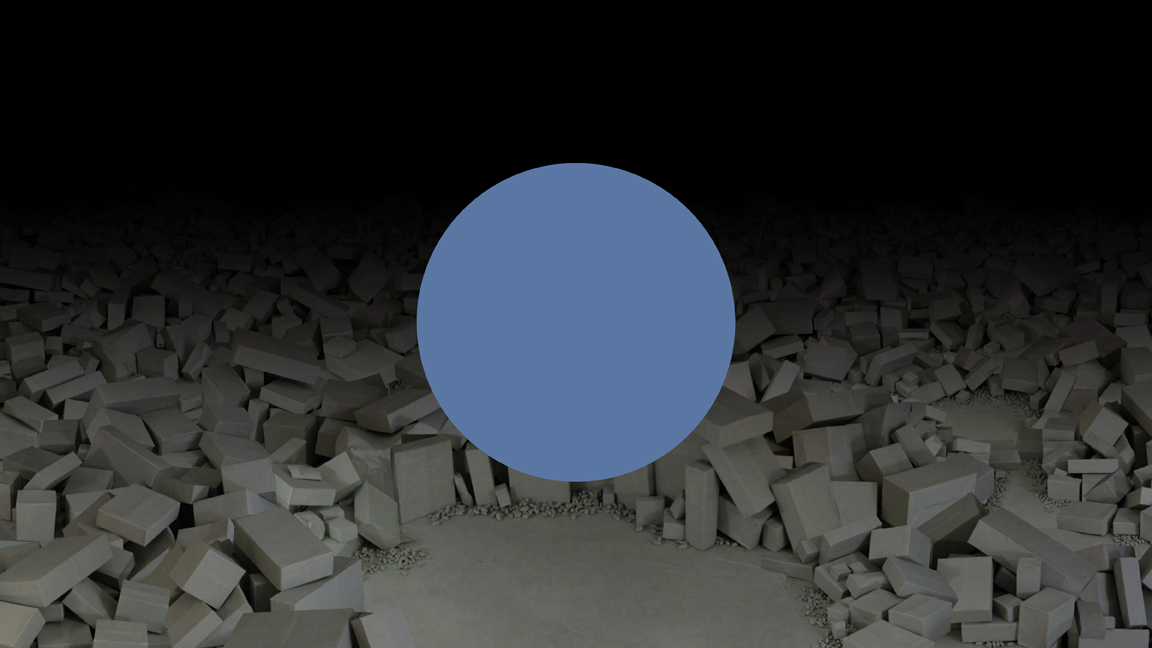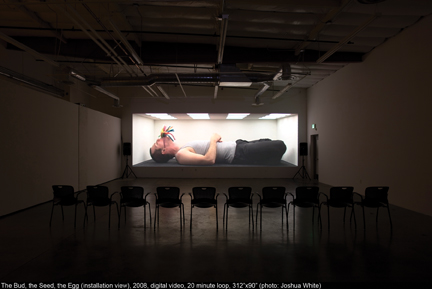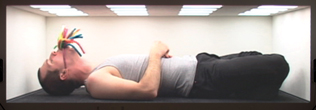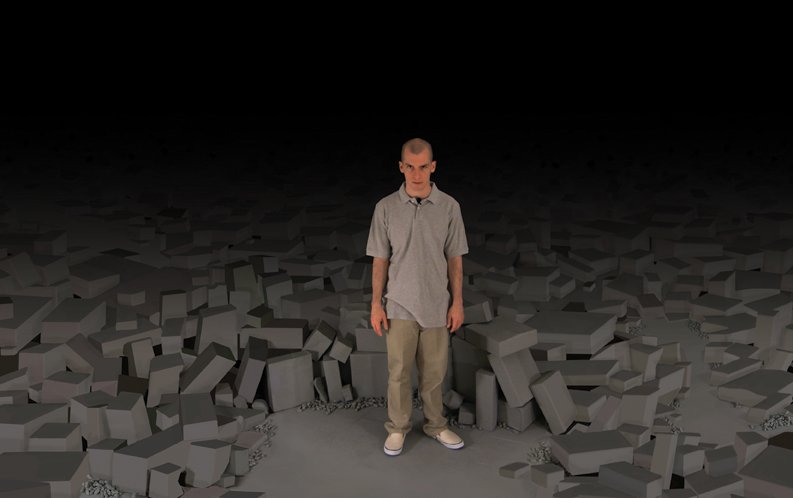Mores McWreath
Curated by Andrea Zittel
November 12, 2009 – January 9, 2010
Mores McWreath was born in Washington, PA in 1980 and grew up in ten different cities scattered throughout the South and Midwest. He received a BFA from The Cooper Union for the Advancement of Science and Art in New York and an MFA from the University of Southern California Roski School of Fine Arts in Los Angeles. He attended the Whitney Museum of American Art Independent Study Program in 2008-2009. Recent group exhibitions include: Theoretical Practice at the International Studio and Curatorial Program, New York, 2009; Worlds Away: New Suburban Landscapes at the Walker Art Center, Minneapolis, 2008; End-Times at the Lasso Gallery at the Butcher Shop, Chicago, 2007; Ghosts of Presence: International Emerging Artists' Video at the Art Gallery of York University, Toronto, 2007; and Flex Your Textiles at John Connelly Presents, New York, 2006. His work has been screened in film festivals both nationally and internationally, including the Athens International Film and Video Festival and the Jakarta International Video Festival. He currently teaches at the Cooper Union. McWreath's exhibition at CUE Art Foundation marks his first solo show in New York.
Mores McWreath was born in Washington, PA in 1980 and grew up in ten different cities scattered throughout the South and Midwest. He received a BFA from The Cooper Union for the Advancement of Science and Art in New York and an MFA from the University of Southern California Roski School of Fine Arts in Los Angeles. He attended the Whitney Museum of American Art Independent Study Program in 2008-2009. Recent group exhibitions include: Theoretical Practice at the International Studio and Curatorial Program, New York, 2009; Worlds Away: New Suburban Landscapes at the Walker Art Center, Minneapolis, 2008; End-Times at the Lasso Gallery at the Butcher Shop, Chicago, 2007; Ghosts of Presence: International Emerging Artists' Video at the Art Gallery of York University, Toronto, 2007; and Flex Your Textiles at John Connelly Presents, New York, 2006. His work has been screened in film festivals both nationally and internationally, including the Athens International Film and Video Festival and the Jakarta International Video Festival. He currently teaches at the Cooper Union. McWreath's exhibition at CUE Art Foundation marks his first solo show in New York.
Andrea Zittel was born in 1965 in Escondido California. She received a BFA in painting and sculpture from San Diego State University, and an MFA in sculpture from the Rhode Island School of Design. In the early 1990s she first established her practice in New York. One of her most visible projects in New York was A-Z East, a small row house in Brooklyn which she turned into a showroom testing grounds for her prototypes for living. In 2008 she moved back to the West Coast, eventually settling in the High Desert region next to Joshua Tree National Park. She presently divides her time between A-Z West, located in Joshua Tree, CA, and Los Angeles where she teaches at the University of Southern California. Andrea is a co-organizer of the High Desert Test Sites and is currently organizing two new projects: the A-Z smockshop in Los Angeles, and an as of yet unnamed campground in the High Desert. Her work has been included in group exhibitionssuch as the Venice Biennale, Doccumenta X, Skulture project in Munster, and both the 1995 and the 2004 Whitney Biennials. She has had solo exhibitions at the San Francisco Museum of Modern Art, The Carnegie Museum in Pittsburgh, The Diechtorhallen in Hamburg, The Whitney Museum of American Art at Altria, NY; The Museum for Gegenwartskunst in Basel and the The Louisiana Museum in Denmark. Her traveling survey show Critical Space recently traveled to The New Museum, The Contemporary Arts Museum, Houston, TX; the Albright Knox museum in Buffalo, NY; the Los Angeles Museum of Contemporary Art, and the Vancouver Art Gallery. Andrea Zittel is represented by Andrea Rosen Gallery in New York City, Regen Projects in Los Angeles, Sadie Coles HQ in London, Massimo DeCarlo in Milan and Spruth-Magers in Munich.
ARTIST'S STATEMENT
My art interrogates and restages the fragmented nature of human subjectivity using video, photography, sculpture, and drawing. These artworks actively oppose the dominant cultural assumption of a unified subject. This investigation often leads to a deconstructive self-analysis. It is not a need to “know” one’s true self because that seems an impossible task, but it is rather a need to make public the theater of perceptions that form individual subjectivities. The goal is to take the vaudevillian theater of the mind and project it out for others to access for the sake of identification. The Nietzschean concept of Perspectivism posits: “In so far as the word ‘knowledge’ has any meaning, the world is knowable; but it is interpretable otherwise, it has no meaning behind it, but countless meanings.”
My body and the bodies of others appear in my work as stacks of pieces and parts. These piles of rubble are composed of clips, segments, and quotations from private and public, real and imagined histories. They perform on camera in short bursts of dialogue, action or sculpture. These vignettes allow me to quickly access a broad range of genres, styles, and sources. The Internet has created access routes to a flood of media that I channel through various screens and filter into my work as references, homage, transformations and appropriations. The juxtaposition of fragmentary elements culled from the world of images creates a visual and textual metaphor for the nature of human existence in the face of overwhelming information.
Freedom of choice
Is what you got
Freedom from choice
Is what you want
Within capitalism, consumer choice is offered as a replacement for liberty. The propaganda industry, better known as public relations, leads us to believe that given enough choices to make between products that we will have a general sense of freedom in our lives. This industry generates campaigns for advertising and politics to sell us anything from toothpaste to healthcare reform. My interest is in potentially misreading Devo to support a desire for the “freedom from choice.” If what we are offered in contemporary western culture is “choice” then I believe it is a vital thought experiment to seek out a “discourse of the other of choice.” Roland Barthes’ idea of “The Neutral” is that which “baffles the paradigm” and this is the territory I am striving to reach in my artwork. Paradigmatic thinking demands that a conclusion be found and that a final meaning be determined. I have an ardent, burning desire to generate art and ideas beyond the binary.
CURATOR'S STATEMENT
by Andrea Zittel
About a year ago I was walking down 23rd street between 7th and 8th. It had rained earlier in the day and the street lined with piles of damp black plastic trash bags waiting for pickup, and near one of the piles of bags was a semi-wet piece of paper with clumsy scrawled crayon writing that said: “think with your head.”
Learning to think with our heads, or to think critically, is the benchmark for becoming an engaged adult participant in the discourse of contemporary art. But before critical perspective enters the door we think with our stomachs, relying on intuitive barometers like gut reaction. Often when I look at Mores McWreath’s work I feel like I’ve exhumed my teenage gut, enmeshed with pre-critical sensory confusion. Without knowing any of the particulars about McWreath’s upbringing, I instinctively believe that he grew up in a suburb just like I did, and that even though he was generally content, he simultaneously experienced that same latent sense of foreboding that something was “off” in the world.
Most of the dialog in McWreath’s videos is found (or pillaged) rather than his own, and it is clear that he objectively “gets” the emptiness of living in a culture that oppresses its citizens via the empty rhetoric of freedom. But it is also clear in his work that he is a fully “indoctrinated” participant in this same consumer culture. Without giving up on the big questions(Why are we here? What is life for? What is our purpose?), McWreath points to a world in which meaningful relationships to labor, other people or self-empowerment can easily be relinquished, in exchange for the ever evasive fulfillment promised by a continual consumption of commodities.
Similar to consumer culture that offers us variety without granting choice, McWreath’s videos are generally comprised of clips that fit together in a seeming interchangeable order. Rather than discrete works, each episode is in a sense a cellular segment that can be reconfigured into the evolving recombination that creates the larger whole. The repetitive order of his work also brings to mind the dictate of the earlier generation of minimalists who used the stance of “One thing after another” as a means to eschew subjective composition in favor of a more rote sequence that was the earmark of capitalist modes of production.
McWreath’s work is repetitive, smart, juvenile, considered and foolish. The videos have a handmade feel – as if they were crafted in the corner of a bedroom and aren’t sure how to be public. And when they do go public it can be through many various channels of distribution including Bittorrent, YouTube and Vimeo. Or then again they may just as easily be projected supersize on the walls of the white cube. The image and content privilege neither the artworld nor the realm of internet techies, and the medium doesn't dominate the message. Or in the words of McWreath when talking about his decision to post his videos on line -“I don’t see the point of hiding it from anyone.”
View CATALOGUE
YOUNG ART CRITICS: Cameron Shaw on Mores McWreath




